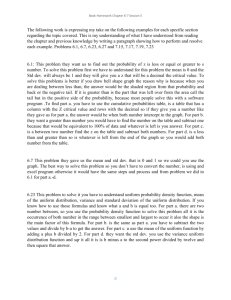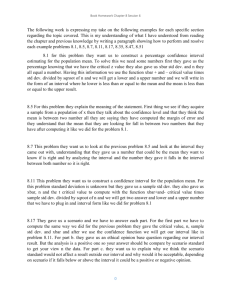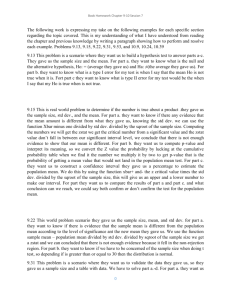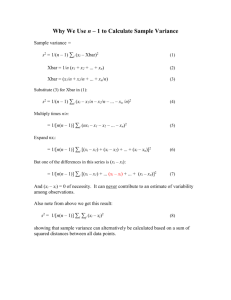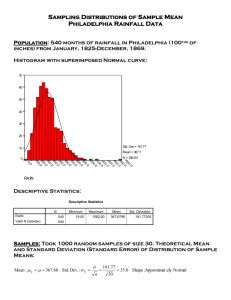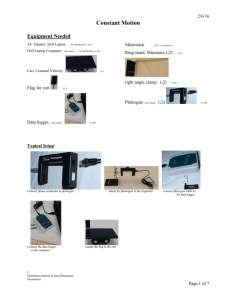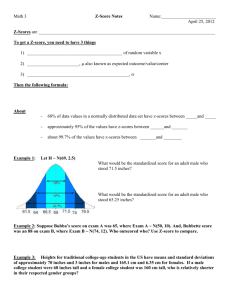Estimation with Confidence
advertisement
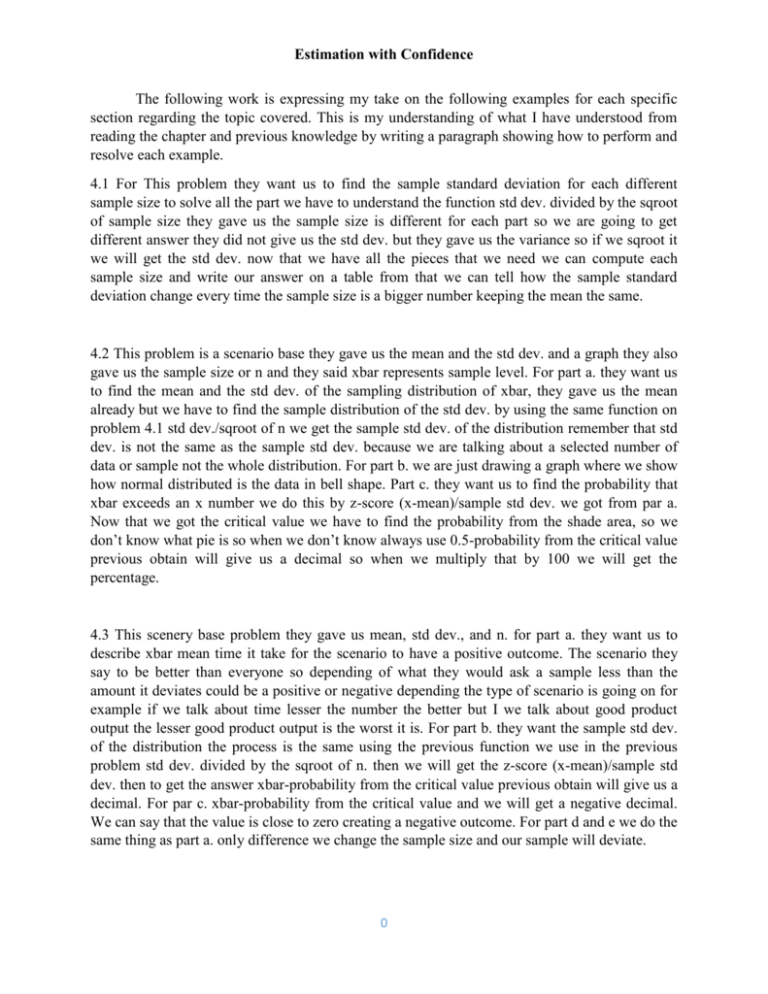
Estimation with Confidence The following work is expressing my take on the following examples for each specific section regarding the topic covered. This is my understanding of what I have understood from reading the chapter and previous knowledge by writing a paragraph showing how to perform and resolve each example. 4.1 For This problem they want us to find the sample standard deviation for each different sample size to solve all the part we have to understand the function std dev. divided by the sqroot of sample size they gave us the sample size is different for each part so we are going to get different answer they did not give us the std dev. but they gave us the variance so if we sqroot it we will get the std dev. now that we have all the pieces that we need we can compute each sample size and write our answer on a table from that we can tell how the sample standard deviation change every time the sample size is a bigger number keeping the mean the same. 4.2 This problem is a scenario base they gave us the mean and the std dev. and a graph they also gave us the sample size or n and they said xbar represents sample level. For part a. they want us to find the mean and the std dev. of the sampling distribution of xbar, they gave us the mean already but we have to find the sample distribution of the std dev. by using the same function on problem 4.1 std dev./sqroot of n we get the sample std dev. of the distribution remember that std dev. is not the same as the sample std dev. because we are talking about a selected number of data or sample not the whole distribution. For part b. we are just drawing a graph where we show how normal distributed is the data in bell shape. Part c. they want us to find the probability that xbar exceeds an x number we do this by z-score (x-mean)/sample std dev. we got from par a. Now that we got the critical value we have to find the probability from the shade area, so we don’t know what pie is so when we don’t know always use 0.5-probability from the critical value previous obtain will give us a decimal so when we multiply that by 100 we will get the percentage. 4.3 This scenery base problem they gave us mean, std dev., and n. for part a. they want us to describe xbar mean time it take for the scenario to have a positive outcome. The scenario they say to be better than everyone so depending of what they would ask a sample less than the amount it deviates could be a positive or negative depending the type of scenario is going on for example if we talk about time lesser the number the better but I we talk about good product output the lesser good product output is the worst it is. For part b. they want the sample std dev. of the distribution the process is the same using the previous function we use in the previous problem std dev. divided by the sqroot of n. then we will get the z-score (x-mean)/sample std dev. then to get the answer xbar-probability from the critical value previous obtain will give us a decimal. For par c. xbar-probability from the critical value and we will get a negative decimal. We can say that the value is close to zero creating a negative outcome. For part d and e we do the same thing as part a. only difference we change the sample size and our sample will deviate. 0 Estimation with Confidence 4.4 They gave us n, xbar, confidence interval level, and variance. For part a-c to find the max we us the critical value from the confidence percentage and we apply the function xbar + and – zvalue times the standard deviation (we get from sqroot the variance) divided by sqroot of the sample size, that will give us a two values a min and a max and to solve the other to part we will just change sample size. 4.5 This scenery problem they gave us n, xbar, sample std dev. and the confidence level where we will obtain the z value to perform the function we previously did for 4.4 xbar + and – zvalue times the sample standard deviation divided by sqroot of the sample size we will get a min and a max with that information we can solve their question. 4.6 Give two reason why the CLT-based interval estimation procedure for the population mean may not be applicable when the sample size is small. We understand that the central limit theorem works every time the sample size is bigger it does not work for small sample because every time you increase the sample the closer it becomes a normal distribution and if you get smaller sample it is the opposite. 4.7 This problem they gave a sample of number and we can obtain xbar, n, sample std dev. The only difference is that they gave two different confidence intervals so to solve it we are just changing the z value by performing the following function xbar + and – zvalue times the sample standard deviation divided by sqroot of the sample size, and we will get a max and a min . 4.8 For this problem they gave us two samples we have to construct different confidence interval for each part by using the following formula xbar1-xbar2+ and – z value times the sqroot of sample std dev1( we get that by sqroot the variance because that’s the only piece they gave us) divided by n1 plus sample std dev2( we get that by sqroot the variance because that’s the only piece they gave us) divided by n2 and we will get two values one bigger than the other and we do this for each part two get the answer the reason we are doing it this is because there are two sample data we are working with. 4.9 This problem is the same as the above problem the only different is a scenario base problem part a we have to compare both data so we have to formula xbar1-xbar2+ and – z value times the sqroot of sample std dev1divided by n1 plus sample std dev2 divided by n2 for part b. we answer the question with the result from part a. to see if the outcome of the scenario is positive or negative by accepting or rejecting the scenery solution. 1 Estimation with Confidence 4.10 They gave us a table with to population and a confined interval where we can obtain the zvalue or critical value. We use the formula dbar1-dbar2+ and – z value times the sqroot of sample std dev1divided by n1 plus sample std dev2 divided by n2 the only difference is a dbar not xbar and we have to obtain dbar by summing the table difference and dividing it by sample number and we will get two values from the function. 4.11 For this problem they gave us xbar, sample std dev. and n, and we have to find the variance for the following confidence interval for each different values we also have to get a number from the chi-squared table. WE have to use the function n minus one times sample st dev. raised to the second power divided by critical value raised to the second power on one side the other side of the interval is the same but the critical value is divided by 2 and we would get the result. 2
